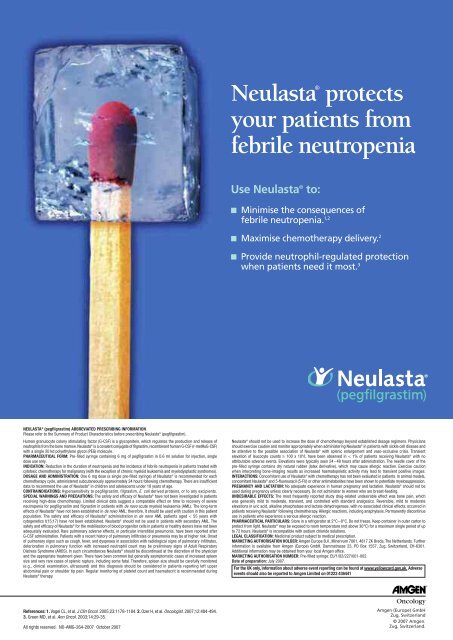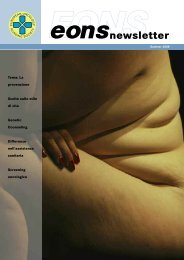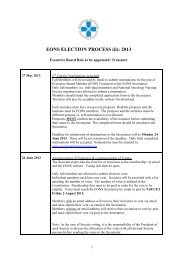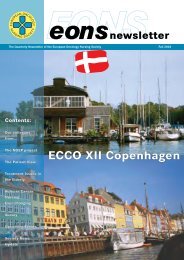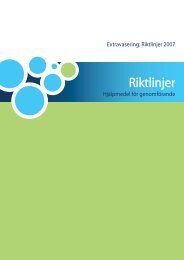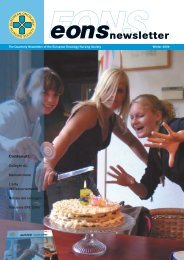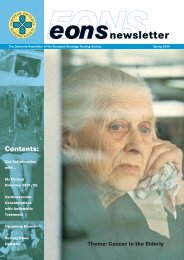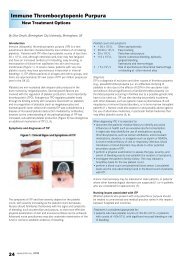Opmaak 1 - the European Oncology Nursing Society
Opmaak 1 - the European Oncology Nursing Society
Opmaak 1 - the European Oncology Nursing Society
Create successful ePaper yourself
Turn your PDF publications into a flip-book with our unique Google optimized e-Paper software.
Neulasta protects<br />
® your patients from<br />
febrile neutropenia<br />
Use Neulasta ® to:<br />
■ Minimise <strong>the</strong> consequences of<br />
febrile neutropenia. 1,2<br />
■ Maximise chemo<strong>the</strong>rapy delivery. 2<br />
■ Provide neutrophil-regulated protection<br />
when patients need it most. 3<br />
NEULASTA ® (pegfilgrastim) ABBREVIATED PRESCRIBING INFORMATION<br />
Please refer to <strong>the</strong> Summary of Product Characteristics before prescribing Neulasta ® (pegfilgrastim).<br />
Human granulocyte colony stimulating factor (G-CSF) is a glycoprotein, which regulates <strong>the</strong> production and release of<br />
neutrophils from <strong>the</strong> bone marrow. Neulasta ® is a covalent conjugate of filgrastim, recombinant human G-CSF (r-metHuG-CSF)<br />
with a single 20 kd polyethylene glycol (PEG) molecule.<br />
be attentive to <strong>the</strong> possible association of Neulasta ®<br />
PHARMACEUTICAL FORM: Pre-filled syringe containing 6 mg of pegfilgrastim in 0.6 ml solution for injection, single elevation of leucocyte counts ≥ 100 x 10 9 /L have been observed in < 1% of patients receiving Neulasta ®<br />
dose use only.<br />
INDICATION: Reduction in <strong>the</strong> duration of neutropenia and <strong>the</strong> incidence of febrile neutropenia in patients treated with<br />
cytotoxic chemo<strong>the</strong>rapy for malignancy (with <strong>the</strong> exception of chronic myeloid leukaemia and myelodysplastic syndromes).<br />
DOSAGE AND ADMINISTRATION: One 6 mg dose (a single pre-filled syringe) of Neulasta ® is recommended for each<br />
chemo<strong>the</strong>rapy cycle, administered subcutaneously approximately 24 hours following chemo<strong>the</strong>rapy. There are insufficient<br />
data to recommend <strong>the</strong> use of Neulasta ® in children and adolescents under 18 years of age.<br />
CONTRAINDICATIONS: Hypersensitivity to pegfilgrastim, filgrastim, E. coli derived proteins, or to any excipients.<br />
SPECIAL WARNINGS AND PRECAUTIONS: The safety and efficacy of Neulasta ® have not been investigated in patients<br />
receiving high-dose chemo<strong>the</strong>rapy. Limited clinical data suggest a comparable effect on time to recovery of severe<br />
neutropenia for pegfilgrastim and filgrastim in patients with de novo acute myeloid leukaemia (AML). The long-term<br />
effects of Neulasta ® have not been established in de novo AML; <strong>the</strong>refore, it should be used with caution in this patient<br />
population. The safety and efficacy of Neulasta ® administration in de novo AML patients aged < 55 years with<br />
cytogenetics t(15;17) have not been established. Neulasta ® should not be used in patients with secondary AML. The<br />
safety and efficacy of Neulasta ® for <strong>the</strong> mobilisation of blood progenitor cells in patients or healthy donors have not been<br />
adequately evaluated. Rare pulmonary adverse effects, in particular interstitial pneumonia, have been reported after<br />
G-CSF administration. Patients with a recent history of pulmonary infiltrates or pneumonia may be at higher risk. Onset<br />
of pulmonary signs such as cough, fever, and dyspnoea in association with radiological signs of pulmonary infiltrates,<br />
deterioration in pulmonary function with increased neutrophil count may be preliminary signs of Adult Respiratory<br />
Distress Syndrome (ARDS). In such circumstances Neulasta ® should be discontinued at <strong>the</strong> discretion of <strong>the</strong> physician<br />
and <strong>the</strong> appropriate treatment given. There have been common but generally asymptomatic cases of increased spleen<br />
size and very rare cases of splenic rupture, including some fatal. Therefore, spleen size should be carefully monitored<br />
(e.g., clinical examination, ultrasound) and this diagnosis should be considered in patients reporting left upper<br />
abdominal pain or shoulder tip pain. Regular monitoring of platelet count and haematocrit is recommended during<br />
Neulasta ® <strong>the</strong>rapy.<br />
References: 1. Vogel CL, et al. J Clin Oncol. 2005;23:1178-1184. 2. Ozer H, et al. Oncologist. 2007;12:484-494.<br />
3. Green<br />
36 - MD, et al. Ann Oncol. 2003;14:29-35.<br />
NEWSLETTER WINTER 2007 All rights reserved. NO-AMG-264-2007 October 2007<br />
Neulasta ® should not be used to increase <strong>the</strong> dose of chemo<strong>the</strong>rapy beyond established dosage regimens. Physicians<br />
should exercise caution and monitor appropriately when administering Neulasta ® in patients with sickle cell disease and<br />
with splenic enlargement and vaso-occlusive crisis. Transient<br />
with no<br />
attributable adverse events. Elevations were typically seen 24–48 hours after administration. The needle cover of <strong>the</strong><br />
pre-filled syringe contains dry natural rubber (latex derivative), which may cause allergic reaction. Exercise caution<br />
when interpreting bone-imaging results as increased haematopoietic activity may lead to transient positive images.<br />
INTERACTIONS: Concomitant use of Neulasta ® with chemo<strong>the</strong>rapy has not been evaluated in patients. In animal models,<br />
concomitant Neulasta ® and 5-fluorouracil (5-FU) or o<strong>the</strong>r antimetabolites have been shown to potentiate myelosuppression.<br />
PREGNANCY AND LACTATION: No adequate experience in human pregnancy and lactation. Neulasta ® should not be<br />
used during pregnancy unless clearly necessary. Do not administer to women who are breast-feeding.<br />
UNDESIRABLE EFFECTS: The most frequently reported study drug-related undesirable effect was bone pain, which<br />
was generally mild to moderate, transient, and controlled with standard analgesics. Reversible, mild to moderate<br />
elevations in uric acid, alkaline phosphatase and lactate dehydrogenase, with no associated clinical effects, occurred in<br />
patients receiving Neulasta ® following chemo<strong>the</strong>rapy. Allergic reactions, including anaphylaxis. Permanently discontinue<br />
use in patients who experience a serious allergic reaction.<br />
PHARMACEUTICAL PARTICULARS: Store in a refrigerator at 2°C–8°C. Do not freeze. Keep container in outer carton to<br />
protect from light. Neulasta ® may be exposed to room temperature (not above 30°C) for a maximum single period of up<br />
to 72 hours. Neulasta ® is incompatible with sodium chloride solutions.<br />
LEGAL CLASSIFICATION: Medicinal product subject to medical prescription.<br />
MARKETING AUTHORISATION HOLDER: Amgen Europe B.V., Minervum 7061, 4817 ZK Breda, The Ne<strong>the</strong>rlands. Fur<strong>the</strong>r<br />
information is available from Amgen (Europe) GmbH, Dammstrasse 23, PO Box 1557, Zug, Switzerland, CH-6301.<br />
Additional information may be obtained from your local Amgen office.<br />
MARKETING AUTHORISATION NUMBER: Pre-filled syringe: EU/1/02/227/001-002.<br />
Date of preparation: July 2007.<br />
For <strong>the</strong> UK only, information about adverse event reporting can be found at www.yellowcard.gov.uk. Adverse<br />
events should also be reported to Amgen Limited on 01223 436441<br />
Amgen (Europe) GmbH<br />
Zug, Switzerland<br />
© 2007 Amgen.<br />
Zug, Switzerland.


